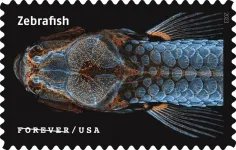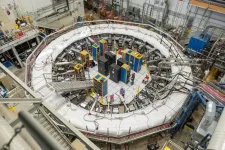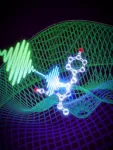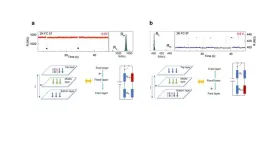NIH zebrafish research included in US Postal Service’s “Life Magnified” stamps
2023-08-10
(Press-News.org)
A microscopy image created by National Institutes of Health researchers is part of the “Life Magnified” stamp panel issued today by the United States Postal Service (USPS®). The NIH zebrafish image, which was taken to understand lymphatic vessel development in the brain, merges 350 individual images to reveal a juvenile zebrafish with a fluorescently tagged skull, scales and lymphatic system.
“Zebrafish are used as a model for typical and atypical human development. It is surprising how much we have in common with zebrafish,” said Diana W. Bianchi, director of NIH’s Eunice Kennedy Shriver National Institute of Child Health and Human Development (NICHD), which generated the image. “NIH research affects our lives every day. My hope is that this postage stamp will help spur conversations and appreciation for the importance of basic science research.”
The image was taken by NICHD’s Daniel Castranova, an aquatic research specialist, with assistance from former trainee Bakary Samasa. The research was conducted in the Section on Vertebrate Organogenesis, led by principal investigator Brant Weinstein, Ph.D. The lab is devoted to understanding mechanisms guiding the formation of blood and lymphatic vessels. The image also received top honor in the 46th annual Nikon Small World Photomicrography Competition in 2020.
Findings from the microscopy image were published in Circulation Research and featured on the journal’s cover. The work led to a groundbreaking discovery that zebrafish have lymphatic vessels inside their skull. These vessels were previously thought to occur only in mammals, and their discovery in fish could expedite and revolutionize research related to treatments for diseases that occur in the human brain, including cancer and Alzheimer’s.
“Life Magnified” is a set of 20 Forever® stamps (Forever stamps will always be equal in value to the current First-Class Mail 1-ounce price). This collection includes work from other researchers relevant to the broader NIH community. Two creators lead microscopy core facilities often used by NIH-funded researchers at their universities. Tagide deCarvalho, Ph.D., is director of the Keith R. Porter Imaging Facility at the University of Maryland, Baltimore County. She created “Moss Leaves” and “Mold Spores.” Jason M. Kirk is director of the Optical Imaging & Vital Microscopy Core at Baylor College of Medicine. He created “Oak Leaf Surface” and “Mouse Brain Neurons.”
###
About the Eunice Kennedy Shriver National Institute of Child Health and Human Development (NICHD): NICHD leads research and training to understand human development, improve reproductive health, enhance the lives of children and adolescents, and optimize abilities for all. For more information, visit https://www.nichd.nih.gov.
About the National Institutes of Health (NIH): NIH, the nation's medical research agency, includes 27 Institutes and Centers and is a component of the U.S. Department of Health and Human Services. NIH is the primary federal agency conducting and supporting basic, clinical, and translational medical research, and is investigating the causes, treatments, and cures for both common and rare diseases. For more information about NIH and its programs, visit https://www.nih.gov.
END
[Attachments] See images for this press release:

ELSE PRESS RELEASES FROM THIS DATE:
2023-08-10
Brazilian researchers combined environmental physical, social and economic indicators to create an index that measures a region’s vulnerability and used it to analyze the basins of the Parnaíba River and São Francisco River in the Northeast of Brazil. The index is named SEVI (for Socio-Environmental Vulnerability).
The Parnaíba and São Francisco basins are considered crucial to agricultural expansion and biodiversity conservation. They contain more than 780 municipalities and part of the semi-arid Caatinga and savanna-like Cerrado biomes, which are threatened ...
2023-08-10
ROCHESTER, Minn. — Using human "mini-brain" models known as organoids, Mayo Clinic and Yale University scientists have discovered that the roots of autism spectrum disorder may be associated with an imbalance of specific neurons that play a critical role in how the brain communicates and functions. The specific cells are known as excitatory cortical neurons.
The new study is published in Nature Neuroscience.
Findings
The team found an abnormal imbalance of excitatory ...
2023-08-10
Batavia, Ill., Aug. 10, 2023 – Physicists now have a brand-new measurement of a property of the muon called the anomalous magnetic moment that improves the precision of their previous result by a factor of 2.
An international collaboration of scientists working on the Muon g-2 experiment at the U.S. Department of Energy’s Fermi National Accelerator Laboratory announced the much-anticipated updated measurement on Aug. 10. This new value bolsters the first result they announced in April 2021 and sets up a showdown between theory and experiment over 20 years in the making.
“We’re really probing new territory. We’re determining ...
2023-08-10
Bringing ultrafast physics to structural biology has revealed the dance of molecular ‘coherence’ in unprecedented clarity.
How molecules change when they react to stimuli such as light is fundamental in biology, for example during photosynthesis. Scientists have been working to unravel the workings of these changes in several fields, and by combining two of these, researchers have paved the way for a new era in understanding the reactions of protein molecules fundamental for life.
The large international research team, led by Professor ...
2023-08-10
CHAPEL HILL, N.C. – Over the past decade, the gut microbiome has gained significant interest by scientists and non-scientists alike. Recent research has shown that the bacteria and other microbes in our gut play a supporting role in immunity, metabolism, digestion, and the fight against "bad bacteria" that try to invade our bodies.
However, new research published in Nature Biotechnology by Angela Wahl, PhD, Balfour Sartor, MD, J. Victor Garcia, PhD, and UNC School of Medicine colleagues others has revealed that the microbiome may not as always be protective against human pathogens.
Using a first-of-its-kind ...
2023-08-10
New Haven, Conn. — Two distinct neurodevelopmental abnormalities that arise just weeks after the start of brain development have been associated with the emergence of autism spectrum disorder, according to a new Yale-led study in which researchers developed brain organoids from the stem cells of boys diagnosed with the disorder.
And, researchers say, the specific abnormalities seem to be dictated by the size of the child’s brain, a finding that could help doctors and researchers to diagnosis and treat autism in the future.
The findings were ...
2023-08-10
Mountain ranges play a key role in global climate, altering weather and shaping the flora and fauna that inhabit their slopes and the valleys below. As warm air rises windward grades and cools, moisture condenses into rain and snow. On the leeward side, it’s quite the opposite. Deserts prevail, a phenomenon known as rain shadow. Thus, the way mountain ranges form is a matter of intense interest among those who study and model climates of the past.
That debate will soon grow more heated with a new paper in the journal Nature Geoscience. A team of researchers ...
2023-08-10
Francis Crick Institute press release
Under strict embargo: 16:00hrs BST 10 August 2023
Peer reviewed
Observational study
Cells
Researchers at the Francis Crick Institute and UCL Queen Square Institute of Neurology, working with technology company Faculty AI, have shown that machine learning can accurately predict subtypes of Parkinson’s disease using images of patient-derived stem cells.
Their work, published today in Nature Machine Intelligence, has shown that computer models can accurately classify four subtypes of Parkinson’s disease, with one reaching an accuracy of 95%. This could pave the way for personalised medicine and targeted drug discovery.
Parkinson’s ...
2023-08-10
Random Telegraph Noise (RTN), a type of unwanted electronic noise, has long been a nuisance in electronic systems, causing fluctuations and errors in signal processing. However, a team of researchers from the Center for Integrated Nanostructure Physics within the Institute for Basic Science (IBS), South Korea has made an intriguing breakthrough that can potentially harness these fluctuations in semiconductors. Led by Professor LEE Young Hee, the team reported that magnetic fluctuations and their gigantic RTN signals can be generated in a vdW-layered semiconductor by introducing vanadium in ...
2023-08-10
Boston – Researchers from Dana-Farber Cancer Institute have found a way to use artificial intelligence (AI) to diagnose muscle wasting, called sarcopenia, in patients with head and neck cancer. AI provides a fast, automated, and accurate assessment that is too time-consuming and error-prone to be made by humans. The tool, published in JAMA Network Open, could be used by doctors to improve treatment and supportive care for patients.
“Sarcopenia is an indicator that the patient is not doing well. A real-time tool that tells us when a patient is losing muscle mass would trigger us to intervene and do something supportive ...
LAST 30 PRESS RELEASES:
[Press-News.org] NIH zebrafish research included in US Postal Service’s “Life Magnified” stamps






